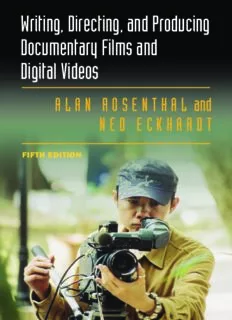
Writing, Directing, and Producing Documentary Films and Digital Videos PDF
Preview Writing, Directing, and Producing Documentary Films and Digital Videos
Writing, Directing, and Producing Documentary Films and Digital Videos A L A N R O S E N T H A L and N E D E C H A R D T FIFTH EDITION Writing, Directing, and Producing Documentary Films and Digital Videos Copyright © 1990, 1996, 2002, 2007, 2016 by Alan Rosenthal All rights reserved. First edition 1990 Fifth edition 2016 Printed in the United States of America 19 18 17 16 4 3 2 1 Cover illustration © iStock.com/allensima Library of Congress Cataloging-in-Publication Data Rosenthal, Alan, [date] Writing, directing, and producing documentary films and digital videos / Alan Rosenthal, Ned Eckhardt. — Fifth edition. pages cm Includes bibliographical references and index. ISBN 978-0-8093-3458-2 (paperback) ISBN 0-8093-3458-5 (paperback) ISBN 978-0-8093-3459-9 (e-book) 1. Documentary films—Production and direction. 2. Documentary films— Authorship. I. Eckhardt, Ned, 1940– II. Title. PN1995.9.D6R65 2015 070.1'8—dc23 2015014944 Printed on recycled paper. The paper used in this publication meets the minimum requirements of American National Standard for Information Sciences—Permanence of Paper for Printed Library Materials, ANSI Z39.48-1992. To my wife, Tirtza, for her continuing support and inspiration A. R. To my wife, Didi, who continues to be the love of my life N. E. Contents Preface to the Fifth Edition ix Preface to the First Edition xiii 1. Introduction 1 Part One. From Idea to First Draft 2. Clearing the Decks 7 3. Getting to Work 17 4. Writing the Proposal 30 5. Research 60 6. Shaping the Film 69 7. Beginning the First Draft 84 8. Completing the First Draft 99 Part Two. Preproduction 9. Budget and Contract 119 10. Preproduction Survey 151 Part Three. Production 11. The Director Prepares 169 12. Directing the Interview 182 13. On Location 197 Part Four. Postproduction 14. Editing 209 15. Writing the Final Narration 228 16. Finishing the Film 265 Part Five. Special Cases 17. Making Your First Film 273 18. Cinema Verité 279 19. Documentary Drama 291 vii viii Contents 20. The History Documentary 311 21. Family Films 327 22. Industrial and Public Relations Films 345 23. Staying Alive: The Producer’s Role, the Web, and Social Media 360 24. Conclusion: Problems and Challenges 379 Appendixes A: Using the Web and Social Media to Prepare for Your Career 389 B: Select Websites 395 Select Bibliography 399 Index 403 Galleries begin on pages 145 and 259 Preface to the Fifth Edition I have always distrusted how-to books, whether they are about sex or about making a million. The authors of such texts seem to me a bit presumptu- ous in trying to teach you things seemingly best learned by experience. And as in love and business, so in film. Documentary is learned by doing, by trial and error. So this is not a book that tells you dogmatically how to go from A to B to C. Instead it’s meant to be a companion to you along the way, offering hints and suggestions by someone who’s traveled the path many times. The hope of the companion is to show you some of the pitfalls and problems of documentary and help you find good solu- tions to the difficult but fascinating task of filmmaking. In essence the aim of this book is to provide something that is today needed more than ever—a one-stop-shopping book that explains in a simple and entertaining way both the technical and the creative sides of documentary filmmaking in the current scene. Again, as in the first edition, the emphasis in the book is on what to say and how to say it and how to do both of these things extremely well. This is a book about the art and technique of visual storytelling—how to tell, in the most effective visual way, great and moving stories about fascinating people (both heroes and villains) and events that have changed history for better or worse. As I very much believe that examples can help you, I’ve referenced over one hundred films, from Nanook of the North to 20 Feet from Stardom, as examples of compelling and creative storytelling. Looking back, I am amazed to discover this is the fifth edition of Writing, Directing, and Producing Documentary Films and Digital Vid- eos. I can’t quite believe that. Why, only a scant few years ago, I pushed away my word processor after completing the fourth edition. “Great,” I thought. “Now I can rest, since my words of wisdom will be good for at least a decade.” Well, I was wrong once again. New equipment, new approaches, new filming methods, the expan- sion of web possibilities and digital video, and so on have all forced me to reconsider how one approaches documentary film and video making today. The fruits of that thinking underpin this new edition. ix
Description: